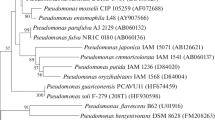Abstract
Pseudomonas sp. B13 was grown in continuous culture on 4-chlorophenol as the only carbon source. Maximum growth rate of 0.4h-1 was observed at a substrate concentration of >0.01 mM and <0.15 mM. In addition to the enzymes of phenol catabolism, high specific 1,2-dioxygenase activities with chlorocatechols as substrates were found. The isomeric monochlorinated phenols were also totally degraded by 4-chlorophenol grown cells. (+)-2,5-Dihydro-4-methyl- and (+)-2,5-dihydro-2-methyl-5-oxo-furan-2-acetic acid were formed in high yield as dead-end catabolites from cooxidation of cresoles.
Several dichlorophenols except 2,6-dichlorophenol were removed from the culture fluid by chlorophenol grown cells. Ring cleavage of chlorinated catechols were shown to be one of the critical steps in chlorophenol catabolism. A catabolic pathway for isomeric chlorophenols is discussed.
Similar content being viewed by others
Abbreviations
- HPLC:
-
High performance liquid chromatography
- DHB:
-
“Dihydrodihydroxybenzoate” 3,5-cyclohexadiene-1,2-diol-1-carboxylic acid
References
Chu, J., Kirsch, E. J.: Utilization of halophenols by a pentachlorophenol metabolizing bacterium. Dev. Ind. Microbiol.14, 264–273 (1973)
Clarke, P. H., Ornston, L. N.: Metabolic pathways and regulation-Part I. In: Genetics and biochemistry ofPseudomonas, pp. 191–261 (P. H. Clarke, M. H. Richmond, eds.). London: Wiley (1975)
Cserjesi, A. J.: Detoxification of chlorinated phenols. Int. Biodeterior. Bull.8, 135–138 (1972)
Dorn, E., Hellwig, M., Reineke, W., Knackmuss, H.-J.: Isolation and characterization of a 3-chlorobenzoate degrading Pseudomonad. Arch. Microbiol.99, 61–70 (1974)
Dorn, E., Knackmuss, H.-J.: Chemical structure and biodegrad-ability of halogenated aromatic compounds. Two catechol 1,2-dioxygenases from a 3-chlorobenzoate-grown Pseudomonad. Biochem. J. (1978a, in press)
Dorn, E., Knackmuss, H.-J.: Chemical structure and biodegrad-ability of halogenated aromatic compounds. Substituent effects on 1,2-dioxygenation of catechol. Biochem. J. (1978 b, in press)
Evans, W. C., Smith, B. S. W., Fernley, H. N., Davies, J. I.: Bacterial metabolism of 2,4-dichlorophenoxyacetate. Biochem. J.122, 543–551 (1971a)
Evans, W. C., Smith, B. S. W., Moss, P., Fernley, H. N.: Bacterial metabolism of 4-chlorophenoxyacetate. Biochem. J.122, 509–517 (1971b)
Fujiwara, M., Golovleva, L. A., Saeki, Y., Nozaki, M., Hayaishi, O.: Extradiol cleavage of 3-substituted catechols by an intradiol dioxygenase, pyrocatechase, from a Pseudomonad. J. Biol Chem.250, 4848–4855 (1975)
Gamar, Y., Gaunt, J. K.: Bacterial metabolism of 4-chloro-2-methylphenoxyacetate. Formation of glyoxylate by sidechain cleavage. Biochem. J.122, 527–531 (1971)
Gaunt, J. K., Evans, W. C.: Metabolism of 4-chloro-2-methylphenoxyacetate. by a soil Pseudomonad. Preliminary evidence for the metabolic pathway. Biochem. J.122, 519–526 (1971a)
Gaunt, J. K., Evans, W. C.: Metabolism of 4-chloromethylphenoxyacetate by a soil Pseudomonad. Ring-fission, lactonizing and delactonizing enzymes. Biochem. J.122, 533–542 (1971b)
Hayaishi, O., Katagiri, M., Rothberg, S.: Studies on oxygenases, Pyrocatechase. J. Biol. Chem.229, 905–920 (1957)
Knackmuss, H.-J., Hellwig, M., Lackner, H., Otting, W.: Cometabolism of 3-methylbenzoate and methylcatechols by a 3-chlorobenzoate utilizingPseudomonas: Accumulation of (+)-2,5-dihydro-4-methyl- and (+)-2,5-dihydro-2-methyl-5-oxofuran-2-acetic acid. Eur. J. Appl. Microbiol.2, 267–276 (1976)
Ornston, L. N.: The conversion of catechol and protocatechuate to β-ketoadipate byPseudomonas putida. III. Enzymes of the catechol pathway. J. Biol. Chem.241, 3795–3799 (1966)
Reineke, W.: Ursachen des verlangsamten biologischen Abbaus halogenierter aromatischer Kohlenwasserstoffe: Modelluntersuchungen an substituierten Benzoaten und 3,5-Cyclohexadien-1,2-diol-1-carbonsäuren Dissertation, Univ. Göttingen (1976)
Reiner, A. M.: Metabolism of aromatic compounds in bacteria. Purification and properties of the catechol-forming enzyme, 3,5-cyclohexadiene-1,2-diol-1-carboxylic acid (NAD+) oxidoreductase. J. Biol. Chem.247, 4960–4965 (1972)
Schmidt, E.: Substituenten-Einflüsse auf die Induktion der Enzyme für den Abbau von meta-Halogenbenzoaten durchPseudomonas Stamm B 13. Diplomarbeit, Univ. Göttingen (1976)
Schmidt, K., Liaaen-Jensen, S., Schlegel, H. G.: Die Carotinoide der Thiorhodaceae. I. Okenon als Hauptcarotinoid vonChromatium okenii Perty. Arch. Mikrobiol.46, 117–126 (1963
Sharpee, K. W., Duxbury, I.M., Alexander, M.: 2,4-Dichlorophenoxyacetate metabolism byArthrobacter sp.: Accumulation of a chlorobutenolide. Appl. Microbiol.26, 445–447 (1973)
Tabak, H. H., Chambers, C. W., Kabler, P. W.: Microbial metabolism of aromatic compounds. I. Decomposition of phenolic compounds and aromatic hydrocarbons by phenol-adapted bacteria. J. Bacteriol.87, 910–919 (1964)
Tiedje, J. M., Duxbury, J. M., Alexander, M., Dawson, J. E.: 2,4-D metabolism: Pathway of degradation of chlorocatechols byArthrobacter sp. J. Agric. Food Chem.17, 1021–1026 (1969)
Tyler, J. E., Finn, R. K.: Growth rates of a Pseudomonad on 2,4-dichlorophenoxyacetic acid and 2,4-dichlorophenol. Appl. Microbiol.28, 181–184 (1974)
Warburg, O., Christian, W.: Isolierung und Kristallisation des Gärungsferments Enolase. Biochem. Z.310, 384–421 (1942)
Author information
Authors and Affiliations
Rights and permissions
About this article
Cite this article
Knackmuss, HJ., Hellwig, M. Utilization and cooxidation of chlorinated phenols byPseudomonas sp. B 13. Arch. Microbiol. 117, 1–7 (1978). https://doi.org/10.1007/BF00689343
Received:
Issue Date:
DOI: https://doi.org/10.1007/BF00689343




